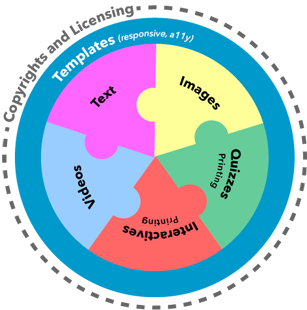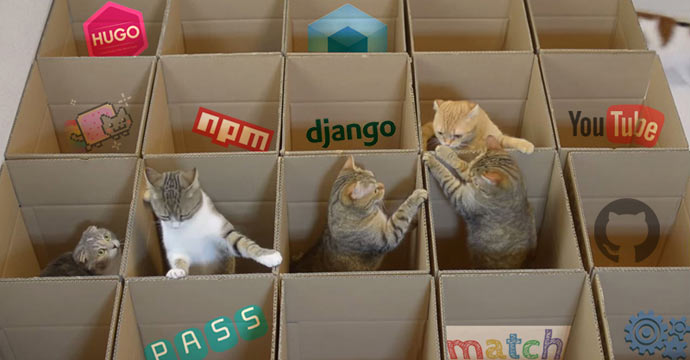This is the second of a three-part summary on the sustainability project of MATCH and PASS.
In the first part of this summary, “Towards Sustainability”, we recounted the circumstances that drove the decision to migrate MATCH and PASS to an open and sustainable framework. We also listed a few questions that we must address before moving forward with the implementation. Here, we’ll outline the solutions and development of the migration process.
Openness and anonymity
First, we needed to define what it meant to have the MATCH and PASS completely “open” to all learners, and what the corollaries of this “openness” were.
MATCH and PASS modules would be independently linkable, and offered as free and open educational resources through external learning management systems. No user data would be collected and no reports would be generated in these two sites. Anyone can access these sites from anywhere using any device and platform.
Corollaries of openness that surfaced immediately were those involving accessibility (a11y), device and platform compatibilities. The original learning modules were tested on multiple browsers, but they were not optimized for tablets, smartphones, and assistive technologies (AT). Many of the JavaScript interactives required generous screen real estate to work properly; therefore, we needed to either redesign or accommodate with graceful degradation.
The user story and module narratives might be affected too. The original quizzes and JavaScript interactives provided instant feedback to guide the learners as they progress through the modules. In the anonymous, open and modular environment, however, we must rethink how this guiding feedback and reporting would take place, and if any revision in content that we implemented would affect learners’ experience.
In addition to opening the learning modules to the world, we’ve placed all the source codes and files for these two sites and the associated interactives in public repositories on Github.
Framework
Since MATCH and PASS have reached the final year of the HRSA grant funding, it was crucial for us to keep the maintenance cost for these sites at a minimum. While Pagetree is stable and robust, we would have to perform necessary periodic maintenance to keep the underlying infrastructure current and secure. This recurring cost will be required ad infinitum.
In addition to cost, we wanted a new framework that:
- is lightweight with low technology stack and doesn’t require a database,
- separates content from templates,
- supports version control tools to track changes to the content and codes, and allows rollbacks,
- allows content editing with Github interface, and
- outputs static content that can be hosted anywhere.
We’ve defined static content as HTML5, images, and JavaScript files delivered to the user exactly as they are stored in the file system. The dynamic interactions on the web pages are all on the client side.

We chose Hugo as the framework for these sites. Hugo is a general-purpose, open-sourced static site generator that renders HTML files as output from content files and layout templates. The framework doesn’t rely on a database; all the content is in simple text files with Markdown or limited HTML formatting that can be revised using any text editing tool. Hugo met the aforementioned requirements, and we considered it a fit for MATCH and PASS. We’ve also used Hugo for other projects at CTL, such as this blog, with great success.
All the source code for MATCH, PASS, and the JavaScript interactives are on Github. We use Jenkins to manage deployment and continuous integration. The HTML and other output files are hosted on Amazon Simple Storage Service.
The following diagram summarizes the migration process of MATCH and PASS into the new framework:

JavaScript interactives
First, we isolated the JavaScript interactives from the Pagetree infrastructure to convert them into standalone and stateless interactives. Parts of the content required rewriting to preserve coherence of context as these interactives exist independently.
Our developer, Susan Dreher, conducted extensive research on bundling, implementing and disseminating JavaScript interactives for these projects. In her CompilED posts, Susan detailed her strategy for bundling these interactives using Webpack and NPM, and testing these unit before dissemination.

These JavaScript interactives are modular, reusable, and can be embedded
anywhere using the iframe element. They require no more than a web server.
They are also available on
Interactives@CTL,
a larger collection of our efforts to build interactive widgets with a minimal
technology stack.
Content exporter
We’ve left out multiple-choice quizzes in MATCH and PASS as part of the core content that included text and images. This was because no data would be collected from these quizzes, and they were narrative tools instead of evaluative devices. All quizzes were converted into client-side JavaScript rhetorical quizzes.
Susan and I wrote a
Python exporter
that converted the core content from Pagetree database to Markdown files
(.md) formatted for Hugo. Codes embedding the JavaScript interactives and
videos were also included in the exporter.
Reporting
We’ve decided that all assessment and evaluative feedback be conducted outside of the MATCH and PASS learning modules. This approach would allow the instructors to use any LMS platform to assess their students independently.
JavaScript interactives and quizzes still offer the user instant feedback, but only for the page’s lifetime. We’ve replaced the backend storage mechanisms with the ability to save results locally via printing or saving off to PDF.
Videos
All the videos in Pagetree MATCH and PASS are mp4 videos streaming from an H264 server through the Flowplayer player. While these videos are available without authentication, they are difficult to search for outside the learning modules. The websites’ traffic data will be recorded using Google Analytics.
We’ve decided to make these videos publicly available as standalone instances on YouTube, complete with more description and information to connect back to the learning modules.
Responsiveness and accessibility
With openness and sustainability come interesting challenges such as responsiveness and improving the sites’ accessibility (a11y). We have committed ourselves to good faith effort in striving for comparable compliance to Section 508 Accessibility Program, and in making sure that both sites and all the standalone JavaScript interactives perform well on all devices including assistive technologies.
I’ve written about making the main sites responsive and accessible in my earlier CompilED post.
Many of the JavaScript interactives, however, were not designed with accessibility or responsiveness in mind. They require screen real-estate, and the user interactions on screen are rather extensive. We’ve decided to keep the constraints on screen size and user interactions, and placed ample notices and alerts whenever those limitations are not met. This is part of our continuing effort to comply with a11y, and we will return to each interactive in the future to make further improvements.
Copyrights and licensing
Finally, the openness of these learning modules necessitates copyrights and licensing information for both content and code. The licenses will allow the MATCH and PASS content and interactives to be used as open educational resources domestically and internationally.
The following diagram summarizes the content pieces put together in the new framework:

In the third part of this summary, “Lessons Learned”, we’ll share what we’ve learned and understood from migrating projects of this size with multiple moving components.
Printed from: https://compiled.ctl.columbia.edu/articles/match-pass-migration-02/

